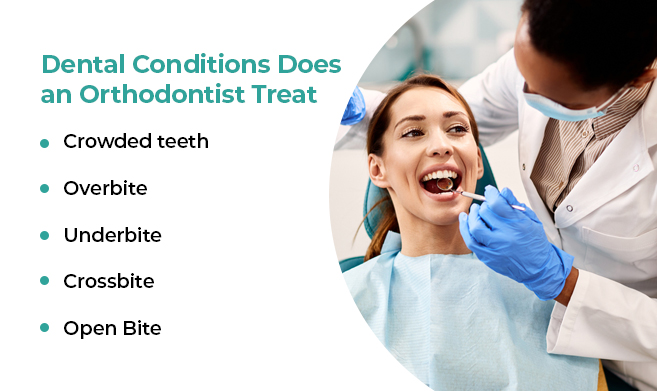The Best Strategy To Use For Legacy Orthodontics
Table of ContentsLegacy Orthodontics Things To Know Before You BuyThe Definitive Guide for Legacy OrthodonticsA Biased View of Legacy OrthodonticsThe Of Legacy OrthodonticsLegacy Orthodontics Can Be Fun For Anyone
At Advanced Orthodontics, we give individuals with a alternative treatment experience. On top of that, we provide flexible treatment timetables, flexible settlement alternatives and a fun, pleasurable experience. leesburg braces. Phone call ( 480) 357-4900 today for additional information and timetable a consultation.An orthodontist is a dental expert trained to identify, stop, and deal with teeth and jaw abnormalities. Orthodontists function with people of all ages, from kids to adults.
Malocclusion, or misaligned teeth, can cause dental concerns, consisting of dental caries, gum disease, and difficult or excruciating chewing. But not every person is born with straight teeth. If you have a bad bite or big spaces in between your teeth, you may intend to consult a dental professional specializing in orthodontic care.
How Legacy Orthodontics can Save You Time, Stress, and Money.
( Photo Credit Report: DigitalVision/Getty Images) Orthodontists utilize dealt with and detachable dental devices, like braces, retainers, and bands, to transform the setting of teeth in your mouth. Orthodontic treatment is for oral abnormalities, including: Jagged teethBite problems, like an overbite or an underbiteCrowded teeth or teeth that are as well much apartJaw misalignmentThe objective of orthodontic therapy is to boost your bite.
A healthy and balanced bite ensures you can eat, eat, and talk appropriately. While you could think about orthodontists as mainly for kids or teenagers who require braces, they can deal with dental issues at any age. Orthodontists attend college, oral institution, and orthodontic school. After graduation, they invest 2 or 3 years in an orthodontic residency program.
, yet not all dental practitioners are orthodontists. They focus on two areas: Exactly how to correctly and securely relocate teeth How to effectively guide advancement in the teeth, jaw, and faceOnce an orthodontist has finished training, they have the alternative to become board accredited.
The 25-Second Trick For Legacy Orthodontics
Misalignment, or malocclusion, is the most common reason people see an orthodontist. It is genetic and is the outcome of size differences between the top and lower jaw or between the jaw and teeth. Malocclusion results in tooth overcrowding, a twisted jaw, or uneven bite patterns. Malocclusion is normally treated with: Your orthodontist attaches metal, ceramic, or plastic square bonds to your teeth.
If you have just small malocclusion, you may be able to make use of clear dental braces, called aligners, rather of conventional dental braces (https://ameblo.jp/legacyortho/entry-12869554383.html). Some people require a headgear to assist move teeth into line with pressure from outside the mouth. After braces or aligners, you'll need to use a retainer. A retainer is a customized device that keeps your teeth in position.
They can develop additional space in the mouth without having to draw teeth. Orthodontists use cords, surgical screws, or plates to sustain your jaw bone.
You might require to see an orthodontist if you have: Crowding or not enough space for every one of your teethOverbite, when your upper teeth come your base teethUnderbite, when your base teeth are as well far forwardSpacing or issues with gapsCrossbite, which is when your top teeth fit behind your bottom teeth when your mouth is closedOpen bite or a vertical space in between your front bottom and top teethMisplaced midline, when the facility of your bottom and upper teeth do not line up Correcting a dental malocclusion can: Make biting, chewing, and speaking easierImprove the proportion of our face and your overall appearanceEase discomfort from temporomandibular joint problemsDifferent your teeth and make them simpler to clean, helping prevent tooth degeneration or dental caries It's commonly a dental expert who initially notices misaligned teeth throughout a routine exam.
The 10-Minute Rule for Legacy Orthodontics

Throughout your first orthodontic examination, you'll likely have: A dental examPhotos taken of your face and smileDental X-raysPanoramic (360 level) X-rays of your face and headImpressions to create mold and mildews of your teethThese examinations will aid your orthodontist recognize just how to wage your therapy. leesburg invisalign. An orthodontist is a dental professional who's had training to treat your teeth and jaw
Orthodontists might do surgical treatment, exams,X-rays,and more to aid you attain a more comfortable, healthier smile. An orthodontist is focused on your bite, so something like a chipped tooth would certainly be managed by a dental professional. Orthodontists are dentists however not all dental experts are orthodontists. Orthodontists are concentrated on your bite, or the means your teeth fit with each other, and the straightness of your teeth.
Ever before asked yourself exactly how stars always appear to have completely lined up teeth? The solution typically hinges on the skilled hands of an orthodontist. But just what does an orthodontist do? Orthodontists are dental specialists that concentrate on dealing with irregularities in the teeth and jaws. Their know-how exceeds just creating a beautiful smile; it reaches boosting your general oral health and feature.
The 9-Minute Rule for Legacy Orthodontics

While dental braces are the most generally identified orthodontic therapy, orthodontists have a diverse toolkit at their disposal. The particular technique picked depends on the intensity of the situation, the individual's age, and specific preferences. These reliable braces use a system of braces bonded to the teeth and attached by cords.
These removable trays are personalized to progressively change the teeth's placement. In instances of narrow jaws, palatal expanders can be used to develop space for appropriate tooth positioning.